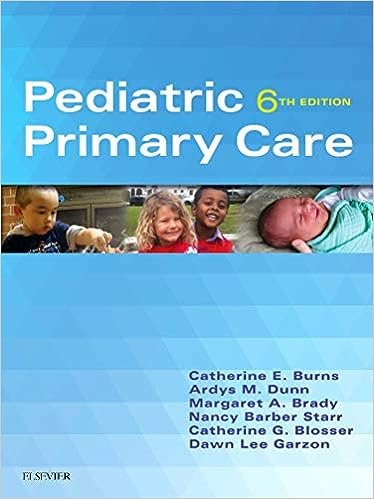Test Bank for Pediatric Primary Care 6th Edition Burns
Questions
1. The parent of an infant asks about using a probiotic medication. What will the ID: 13348441147
primary care pediatric nurse practitioner tell this parent?
A. Probiotic medications have demonstrated efficacy in treating colic.
B. Probiotics are not safe to use to treat infants who have colic.
C. There are no studies showing usefulness of probiotics to manage colic.
D. There is no conclusive evidence about using probiotics to treat colic. Correct
2. A toddler who was born prematurely refuses most solid foods and has poor ID: 13348441137
weight gain. A barium swallow study reveals a normal esophagus. What will the primary care
pediatric nurse practitioner consider next to manage this child’s nutritional needs?
A. Consultation with a dietician
B. Fiberoptic endoscopy evaluation
C. Magnetic resonance imaging
D. Videofluoroscopy swallowing study
3. A toddler is seen in the clinic after a 2day history of intermittent vomiting and ID: 13348441151
diarrhea. An assessment reveals an irritable child with dry mucous membranes, 3second capillary
refill, 2 second recoil of skin, mild tachycardia and tachypnea, and cool hands and feet. The child has
had two wet diapers in the past 24 hours. What will the primary care pediatric nurse practitioner
recommend?
A. Antidiarrheal medication and clear fluids for 24 hours
B. Bolus of IV normal saline in the clinic until improvement
C. Hospital admission for IV rehydration and oral fluids
D. Oral rehydration solution with followup in 24 hours Correct
4. A 9yearold girl has a history of frequent vomiting and her mother has frequent ID: 13348441159
migraine headaches. The child has recently begun having more frequent and prolonged episodes
accompanied by headaches. An exam reveals abnormal eye movements and mild ataxia. What is the
correct action?
A. Begin using an antimigraine medication to prevent headaches.
B. Prescribe ondansetron and lorazepam to help manage symptoms.
C. Reassure the parent that this is expected with cyclic vomiting syndrome.
D. Refer to a pediatric gastroenterologist for further workup. Correct
Correct
5. The parent of a 3monthold reports that the infant arches and gags while feeding ID: 13348441163
and spits up undigested formula frequently. The infant’s weight gain has dropped to the 5th
percentile from the 12th percentile. What is the best course of treatment for this infant?
A. Begin a trial of extensively hydrolyzed protein formula for 2 to 4 weeks. Correct
B. Institute an empiric trial of acid suppression with a proton pump inhibitor (PPI).
C. Perform esophageal pH monitoring to determine the degree of reflux.
D. Reassure the parent that these symptoms will likely resolve by 12 to 24 months.
6. A schoolage child has a 3month history of dull, aching epigastric pain that ID: 13348441139
worsens with eating and awakens the child from sleep. A complete blood count shows a
hemoglobin of 8 mg/dL. What is the next step in management?
A. Administration of H2RA or PPI medications
B. Empiric therapy for H. pylori (HP)
C. Ordering an upper GI series
D. Referral for esophagogastroduodenoscopy (EGD) Correct
7. A 2monthold infant cries up to 4 hours each day and, according to the parents, ID: 13348441153
is inconsolable during crying episodes with fists and legs noted to be tense and stiff. The infant is
breastfeeding frequently but is often fussy during feedings. The physical exam is normal and the
infant is gaining weight normally. What will the primary care pediatric nurse practitioner recommend?
A. A complete workup, including laboratory and radiologic tests
B. Eliminating certain foods from the mother’s diet
C. Empiric treatment with a proton pump inhibitor medication
D. Stopping breastfeeding and beginning a hydrolyzed formula
8. A child is in the clinic after swallowing a metal bead. A radiograph of the GI tract ID: 13348441135
shows a 6 mm cylindrical object in the child’s stomach. The child is able to swallow without difficulty
and is not experiencing pain. What is the correct course of treatment?
A. Administer ipecac to induce vomiting.
B. Have the parents watch for the object in the child’s stool. orrect
C. Insert a nasogastric tube to flush out the object.
D. Refer the child for endoscopic removal of the object.
9. A 10yearold child has had abdominal pain for 2 days, which began in the ID: 13348441161
periumbilical area and then localized to the right lower quadrant. The child vomited once today and
then experienced relief from pain followed by an increased fever. What is the likely diagnosis?
Correct
A. Appendicitis with perforation Correct
B. Gastroenteritis
C. Pelvic inflammatory disease (PID)
D. Urinary tract infection (UTI)
10. An 18monthold child has a 1day history of intermittent, cramping abdominal ID: 13348441157
pain with nonbilious vomiting. The child is observed to scream and draw up his legs during pain
episodes and becomes lethargic in between. The primary care pediatric nurse practitioner notes a
small amount of bloody, mucous stool in the diaper. What is the most likely diagnosis?
A. Appendicitis
B. Gastroenteritis
C. Intussusception Correct
D. Testicular torsion











Reviews
There are no reviews yet.